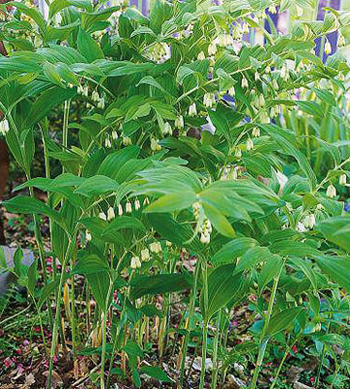Contents:
Common Names | Parts Usually Used | Plant(s) & Culture | Where Found | Medicinal Properties | Biochemical Information
Legends, Myths and Stories | Uses | Formulas or Dosages | Bibliography
Scientific Names

- Polygonatum multiflorum L.
- Polygonatum biflorum L.
- Polygonatum officinale L.
- Polygonatum commutatum
- Liliaceae
- Lily family
Common Names
- Dropberry
- He shou wu (Chinese name)
- Mahmeda (Sanskrit name)
- Meda (Sanskrit name)
- Sealroot
- Sealwort
- Yu-zhu (Chinese name)
Parts Usually Used
Root, rhizome
Back to Top
Description of Plant(s) and Culture
Solomon’s seal is a perennial plant; the thick, horizontal, scarred rootstock produces 1 or 2 erect stems, 1-3 feet high, whose lower half is naked and upper half leafy. The alternate, elliptic to ovate leaves are green with a whitish bloom underneath. 2 to 5 or more greenish-white, bell-shaped flowers hang from the leaf axils from April to August. The fruit is a blue or blue-black berry.
Another variety: Other species of Solomon’s seal have similar properties. A European variety (P. odoratum) contains a substance that lowers the level of blood sugar. This variety has long been used in the Orient for diabetes and is included in many tea mixtures designed to lower blood sugar.
Back to Top
Where Found
Grows in rich woods and thickets in eastern North America, Europe, and Asia. Connecticut to Florida; Texas, Nebraska to Michigan.
Back to Top
Medicinal Properties
Antispasmodic, antibacterial, aphrodisiac, astringent, demulcent, emetic, expectorant, hemostatic, nutritive tonic
Back to Top
Biochemical Information
Convallarin, aspargin, gum, sugar, starch, pectin
Back to Top
Legends, Myths and Stories
Solomon’s seal was so called probably from starlike markings on the rootstock, supposedly reminding us of the Star of David.
Another herb (Smilacina amplexicaulis) is known as Solomon’s seal. Paiute name “Shapui”; Shoshone name “Roy”; The tea from roots for female trouble and internal pains.
Solomon’s seal is reported to take away, in 1 or 2 nights, bruises, black eyes, burning heat of wounds, etc. Also, it will strengthen gums and fasten loosened teeth.
Back to Top
Uses
Mainly for external problems. Makes a good poultice for bruises, inflammations, piles, sores, and wounds and a good wash for skin problems, acne, freckles, and blemishes. Has been used as a wash to relieve poison-ivy. Native Americans made a tea of the rootstock to take for women’s complaints, indigestion, general debility, infertility, diabetes, consumption, dry cough, dehydration, malnutrition, broken bones, promote sound sleep, treat coughs, menopause, laxative, lung ailments, and general internal pains. The fresh root was poulticed, or root tea used externally as a wash, for cuts, bruises, sores, carbuncles, rheumatism, arthritis, and skin irritations.
In Western herbalism it is said to be given to promote healing of broken bones. In Ayurveda it is a kidney tonic and thought to build reproductive secretions. In modern China it is an important herb in treating cardiac diseases, and is thought to be a strong heart tonic.
Back to Top
Formulas or Dosages
Tea: steep 1 oz. of the cut herb in 1 cup of hot water.
Back to Top
Bibliography
![]() Back to Eden
Back to Eden, by Jethro Kloss; Back to Eden Publishing Co., Loma Linda, CA 92354, Original copyright 1939, revised edition 1994
![]() American Folk Medicine
American Folk Medicine, by Clarence Meyer, Meyerbooks, publisher, PO Box 427, Glenwood, Illinois 60425, 1973
![]() The Complete Medicinal Herbal
The Complete Medicinal Herbal, by Penelope Ody, Dorling Kindersley, Inc, 232 Madison Avenue, New York, NY 10016, First American Edition, copyright 1993
![]() Culpeper’s Complete Herbal & English Physician: Updated With 117 Modern Herbs
Culpeper’s Complete Herbal & English Physician: Updated With 117 Modern Herbs, by Nicholas Culpeper, Meyerbooks, publisher, PO Box 427, Glenwood, Illinois 60425, 1990, (reprint of 1814)
![]() Eastern/Central Medicinal Plants
Eastern/Central Medicinal Plants, by Steven Foster and James A. Duke., Houghton Mifflin Company, 215 Park Avenue South, New York, NY 10000
![]() The Herbalist Almanac
The Herbalist Almanac, by Clarence Meyer, Meyerbooks, publisher, PO Box 427, Glenwood, Illinois 60425, copyright 1988, fifth printing, 1994
Herbal Gardening, compiled by The Robison York State Herb Garden, Cornell Plantations, Matthaei Botanical Gardens of the University of Michigan, University of California Botanical Garden, Berkeley., Pantheon Books, Knopf Publishing Group, New York, 1994, first edition
![]() The Herb Book
The Herb Book, by John Lust, Bantam Books, 666 Fifth Avenue, New York, NY. copyright 1974.
 How Indians Use Wild Plants for Food, Medicine & Crafts
How Indians Use Wild Plants for Food, Medicine & Crafts, by Frances Densmore, Dover Publications, Inc., 180 Varick Street, New York, NY 10014, first printed by the United States Government Printing Office, Washington, in 1928, this Dover edition 1974
![]() Indian Herbalogy of North America
Indian Herbalogy of North America, by Alma R. Hutchens, Shambala Publications, Inc., Horticultural Hall, 300 Massachusetts Avenue, Boston, Massachusetts 02115, 1973
![]() Indian Uses of Native Plants
Indian Uses of Native Plants, by Edith Van Allen Murphey, Meyerbooks, publisher, PO Box 427, Glenwood, Illinois 60425, copyright 1958, print 1990
![]() Planetary Herbology
Planetary Herbology, by Michael Tierra, C.A., N.D., O.M.D., Lotus Press, PO Box 325, Twin Lakes. WI 53181., Copyright 1988, published 1992
![]() Webster’s New World Dictionary
Webster’s New World Dictionary, Third College Edition, Victoria Neufeldt, Editor in Chief, New World Dictionaries: A Division of Simon & Schuster, Inc., 15 Columbus Circle, New York, NY 10023
![]() The Yoga of Herbs: An Ayurvedic Guide to Herbal Medicine
The Yoga of Herbs: An Ayurvedic Guide to Herbal Medicine, by Dr. David Frawley & Dr. Vasant Lad, Lotus Press, Twin Lakes, Wisconsin, Second edition, 1988.
 The Rodale Herb Book: How to Use, Grow, and Buy Nature’s Miracle Plants (An Organic gardening and farming book)
The Rodale Herb Book: How to Use, Grow, and Buy Nature’s Miracle Plants (An Organic gardening and farming book), edited by William H. Hylton, Rodale Press, Inc. Emmaus, PA, 18049., 1974
